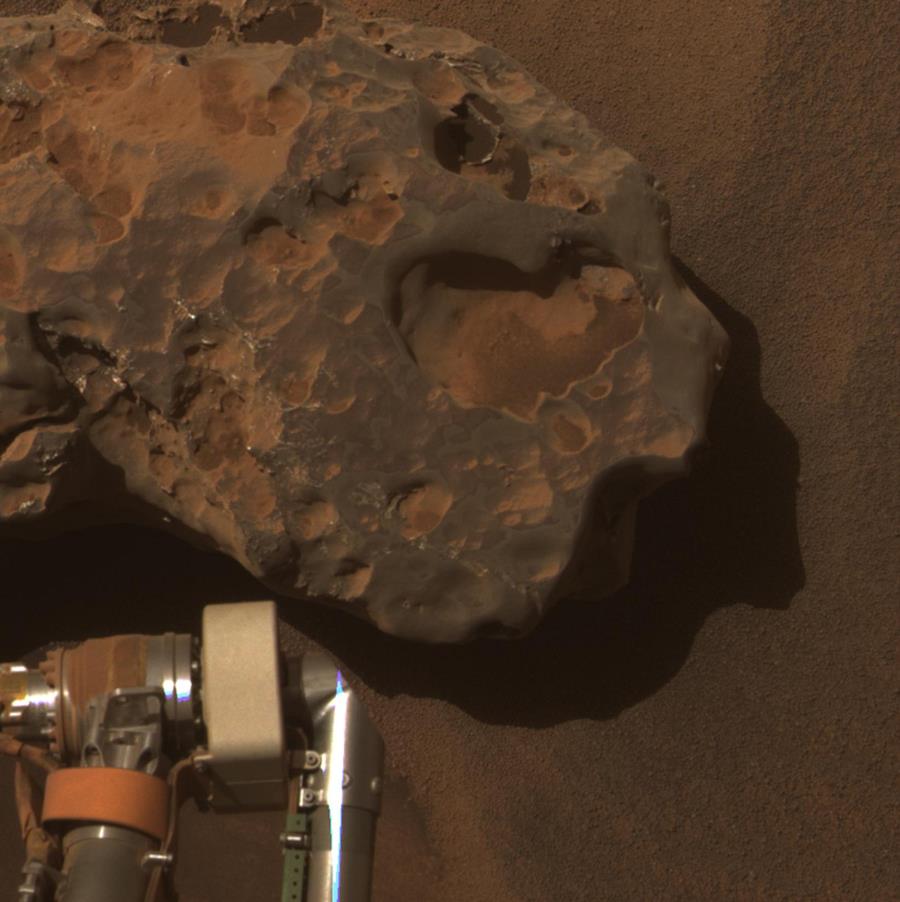|
The Enigmas on Mars 71 |
|||||||
|
Oileán Ruaidh .. Mars Rover Opportunity Approaching Possible Meteorite 09.21.10 PASADENA, Calif. -- Images that NASA's Mars Exploration Rover Opportunity took at the end of an 81-meter (266-foot) drive on Sept. 16 reveal a dark rock about 31 meters (102 feet) away. The rover's science team has decided to go get a closer look at the toaster-sized rock and determine whether it is an iron meteorite. "The dark color, rounded texture and the way it is perched on the surface all make it look like an iron meteorite," said science-team member Matt Golombek of NASA's Jet Propulsion Laboratory, Pasadena, Calif. Opportunity has found four iron meteorites during the rover's exploration of the Meridiani Planum region of Mars since early 2004. Examination of these rocks has provided information about the Martian atmosphere, as well as the meteorites themselves. The newfound rock has been given the informal name "Oileán Ruaidh" (pronounced ay-lan ruah), which is the Gaelic name for an island off the coast of northwestern Ireland. The rock is about 45 centimeters (18 inches) wide from the angle at which it was first seen. Opportunity has driven 23.3 kilometers (14.5 miles) on Mars. The drive to this rock will take the total combined distance driven by Opportunity and its twin, Spirit, to more than 31 kilometers (19.26 miles). Credit:
SOURCE: NASA/JPL/Cornell Opportunity Heading for Possible Meteorite NASA's Mars Exploration Rover Opportunity used its panoramic camera to capture this view of a dark rock that may be an iron meteorite. Part of the rim of Endurance Crater is on the horizon. The rock, about 45 centimeters (18 inches) wide from this angle, was about 31 meters (102 feet) away from Opportunity when the rover took this picture immediately after an 81-meter (266-foot) drive during the 2,363rd Martian day, or sol, of the rover's mission on Mars. The rover science team has decided to approach the rock for a closer look, to determine whether it is an iron meteorite as suggested by the dark color, rounded texture and the way it is perched on the surface. The rock has been given the informal name "Oileán Ruaidh" (pronounced ay-lan ruah), which is the Gaelic name for an island off the coast of northwestern Ireland. The rim of Endeavor crater, still several kilometers or miles away, has been a long-term destination for Opportunity for about two years. Opportunity landed on Mars in January 2004 for what was planned as a three-month mission. |
|||||||
|
.. Credit: NASA/JPL-Caltech/Cornell University Close-up of a Meteorite - 'Oileán Ruaidh' This is an image of the meteorite that NASA's Mars Exploration Rover Opportunity found and examined in September 2010. Opportunity's cameras first revealed the meteorite in images taken on Sol 2363 (Sept. 16, 2010), the 2,363rd Martian day of the rover's mission on Mars. This view was taken with the panoramic camera on Sol 2371 (Sept. 24, 2010). The science team used two tools on Opportunity's arm -- the microscopic imager and the alpha particle X-ray spectrometer -- to inspect the rock's texture and composition. Information from the spectrometer confirmed that the rock is a nickel-iron meteorite. The team informally named the rock "Oileán Ruaidh" (pronounced ay-lan ruah), which is the Gaelic name for an island off the coast of northwestern Ireland. Opportunity departed Oileán Ruaidh and resumed its journey toward the mission's long-term destination, Endeavour Crater, on Sol 2374 (Sept. 28, 2010) with a drive of about 100 meters (328 feet). This view, presented in approximately true color, combines component images taken through three Pancam filters admitting wavelengths of 601 nanometers, 535 nanometers and 482 nanometers. |
|||||||
|
..
Date: 6 January 2005 (2005-01-06) Source (TIFF converted into 100% quality JPEG) Image Credit: NASA/JPL/Cornell
Date: 25 January 2004(2004-01-25) Credi: NASA |
|||||||
| FAIR USE NOTICE: This page contains copyrighted material the use of which has not been specifically authorized by the copyright owner. Pegasus Research Consortium distributes this material without profit to those who have expressed a prior interest in receiving the included information for research and educational purposes. We believe this constitutes a fair use of any such copyrighted material as provided for in 17 U.S.C § 107. If you wish to use copyrighted material from this site for purposes of your own that go beyond fair use, you must obtain permission from the copyright owner. | |||||||
|
|









